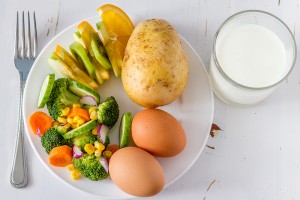A Few Diet Tips to Remember for Better and Long-Term Weight Loss

One of the biggest challenges a person will face when trying to get in shape is changing his/her eating habits. They don’t realize how much excess fat they are ingesting in that one bag of chips, or how much empty calories there are in a can of soda. Those little things are practically harmless alone, but are equivalent to a lot more when piled up. Do yourself a favor and minimize potential setbacks to your success; below are some tips to help you attain your ideal body.
Change your dinner plate to a smaller one. Not too small, though! By doing this, you trick your mind into thinking you are eating a lot when you see your plate full. It also holds less food, so you can better control your servings. Less space means less room for food. In addition to that, try to have six smaller meals a day, rather than three large meals. This speeds up your metabolism because your body gets used to constantly digesting food. Unlike with larger meals spaced farther apart, there is a lull in between.
Eat slowly. Your body needs a little time to register that it has food in the system. If you have the self-control, you can try eating 4-5 bites first, then rest for 15 minutes before finishing the rest of your meal. This makes you feel full, at the same time diminishing the appetite so that less food is consumed. People, who have just started dieting and are still having a hard time adjusting to the changes, might find this helpful.
Another way to avoid storing excess fat is to eat less sugar. This means less soda, less pastries and less carbs. Giving all of them up completely is practically impossible, but at least limit the sugar intake to less than 50% of what you used to ingest before. This is one of the best ways to lose weight, as people don’t even realize that they’re eating so much sugar. A good rule of thumb is to eat only half: half a donut, half a glass of soda, half a slice of cake.
Lastly, limit your sodium intake. Sodium is one of the main causes of all that bloating. For maximum results, keep under 3,800 mg a day. This means staying away from processed foods such as bacon, hotdogs, cup noodles, sausages and many more. Even white bread is high in sodium. Two slices of white bread contains 850 mg of salt. That’s almost 1/3 of the recommended sodium intake per day! Try looking for fresh alternatives, instead of pre-packed products.
Dieting is not too difficult once you have gotten used to it. Allow yourself some cheat days and an extra serving once in a while. Make sure you are still happy and on track, otherwise you could lose your drive to lose weight and stay healthy. Explore other cooking methods as well such as steaming, which is one of the healthiest ways to prepare food. Healthy food need not be bland and boring; all it takes is a little research and creativity to create something that is both nutritious and satisfying.






